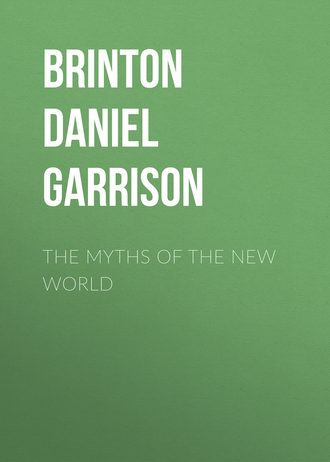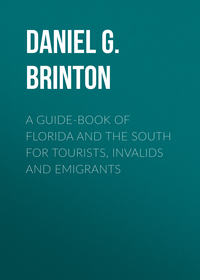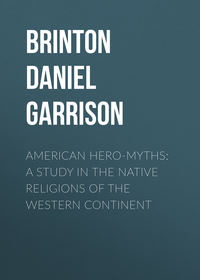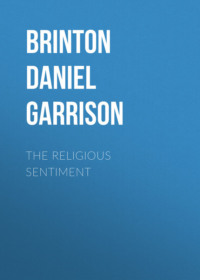 полная версия
полная версияThe Myths of the New World
By far the greater number represent the last destruction of the world to have been by water. A few, however, the Takahlis of the North Pacific coast, the Yurucares of the Bolivian Cordilleras, and the Mbocobi of Paraguay, attribute it to a general conflagration which swept over the earth, consuming every living thing except a few who took refuge in a deep cave.304 The more common opinion of a submersion gave rise to those traditions of a universal flood so frequently recorded by travellers, and supposed by many to be reminiscences of that of Noah.
There are, indeed, some points of striking similarity between the deluge myths of Asia and America. It has been called a peculiarity of the latter that in them the person saved is always the first man. This, though not without exception, is certainly the general rule. But these first men were usually the highest deities known to their nations, the only creators of the world, and the guardians of the race.305
Moreover, in the oldest Sanscrit legend of the flood in the Zatapatha Brahmana, Manu is also the first man, and by his own efforts creates offspring.306
A later Sanscrit work assigns to Manu the seven Richis or shining ones as companions. Seven was also the number of persons in the ark of Noah. Curiously enough one Mexican and one early Peruvian myth give out exactly seven individuals as saved in their floods.307 This coincidence arises from the mystic powers attached to the number seven, derived from its frequent occurrence in astrology. Proof of this appears by comparing the later and the older versions of this myth, either in the book of Genesis, where the latter is distinguished by the use of the word Elohim for Jehovah,308 or the Sanscrit account in the Zatapatha Brahmana with those in the later Puranas.309 In both instances the number seven hardly or at all occurs in the oldest version, while it is constantly repeated in those of later dates.
As the mountain or rather mountain chain of Ararat was regarded with veneration wherever the Semitic accounts were known, so in America heights were pointed out with becoming reverence as those on which the few survivors of the dreadful scenes of the deluge were preserved. On the Red River near the village of the Caddoes was one of these, a small natural eminence, “to which all the Indian tribes for a great distance around pay devout homage,” according to Dr. Sibley.310 The Cerro Naztarny on the Rio Grande, the peak of Old Zuñi in New Mexico, that of Colhuacan on the Pacific Coast, Mount Apoala in Upper Mixteca, and Mount Neba in the province of Guaymi, are some of many elevations asserted by the neighboring nations to have been places of refuge for their ancestors when the fountains of the great deep broke forth.
One of the Mexican traditions related by Torquemada identified this with the mountain of Tlaloc in the terrestrial paradise, and added that one of the seven demigods who escaped commenced the pyramid of Cholula in its memory. He intended that its summit should reach the clouds, but the gods, angry at his presumption, drove away the builders with lightning. This has a suspicious resemblance to Bible stories. Equally fabulous was the retreat of the Araucanians. It was a three-peaked mountain which had the property of floating on water, called Theg-Theg, the Thunderer. This they believed would preserve them in the next as it did in the last cataclysm, and as its only inconvenience was that it approached too near the sun, they always kept on hand wooden bowls to use as parasols.311
The intimate connection that once existed between the myths of the deluge and those of the creation is illustrated by the part assigned to birds in so many of them. They fly to and fro over the waves ere any land appears, though they lose in great measure the significance of bringing it forth, attached to them in the cosmogonies as emblems of the divine spirit. The dove in the Hebrew account appears in that of the Algonkins as a raven, which Michabo sent out to search for land before the muskrat brought it to him from the bottom. A raven also in the Athapascan myth saved their ancestors from the general flood, and in this instance it is distinctly identified with the mighty thunder bird, who at the beginning ordered the earth from the depths. Prometheus-like, it brought fire from heaven, and saved them from a second death by cold.312 Precisely the same beneficent actions were attributed by the Natchez to the small red cardinal bird,313 and by the Mandans and Cherokees an active participation in the event was assigned to wild pigeons. The Navajos and Aztecs thought that instead of being drowned by the waters the human race were transformed into birds and thus escaped. In all these and similar legends, the bird is a relic of the cosmogonal myth which explained the origin of the world from the action of the winds, under the image of the bird, on the primeval ocean.
The Mexican Codex Vaticanus No. 3738 represents after the picture of the deluge a bird perched on the summit of a tree, and at its foot men in the act of marching. This has been interpreted to mean that after the deluge men were dumb until a dove distributed to them the gift of speech. The New Mexican tribes related that all except the leader of those who escaped to the mountains lost the power of utterance by terror,314 and the Quichés that the antediluvian race were “puppets, men of wood, without intelligence or language.” These stories, so closely resembling that of the confusion of tongues at the tower of Babel or Borsippa, are of doubtful authenticity. The first is an entirely erroneous interpretation, as has been shown by Señor Ramirez, director of the Museum of Antiquities at Mexico. The name of the bird in the Aztec tongue was identical with the word departure, and this is its signification in the painting.315
Stories of giants in the days of old, figures of mighty proportions looming up through the mist of ages, are common property to every nation. The Mexicans and Peruvians had them as well as others, but their connection with the legends of the flood and the creation is incidental and secondary. Were the case otherwise, it would offer no additional point of similarity to the Hebrew myth, for the word rendered giants in the phrase, “and there were giants in those days,” has no such meaning in the original. It is a blunder which crept into the Septuagint, and has been cherished ever since, along with so many others in the received text.
A few specimens will serve as examples of all these American flood myths. The Abbé Brasseur has translated one from the Codex Chimalpopoca, a work in the Nahuatl language of Ancient Mexico, written about half a century after the conquest. It is as follows:—
“And this year was that of Ce-calli, and on the first day all was lost. The mountain itself was submerged in the water, and the water remained tranquil for fifty-two springs.
“Now towards the close of the year, Titlahuan had forewarned the man named Nata and his wife named Nena, saying, ‘Make no more pulque, but straightway hollow out a large cypress, and enter it when in the month Tozoztli the water shall approach the sky.’ They entered it, and when Titlacahuan had closed the door he said, ‘Thou shalt eat but a single ear of maize, and thy wife but one also.’
“As soon as they had finished [eating], they went forth and the water was tranquil; for the log did not move any more; and opening it they saw many fish.
“Then they built a fire, rubbing together pieces of wood, and they roasted the fish. The gods Citlallinicue and Citlallatonac looking below exclaimed, ‘Divine Lord, what means that fire below? Why do they thus smoke the heavens?’
“Straightway descended Titlacahuan Tezcatlipoca, and commenced to scold, saying, ‘What is this fire doing here?’ And seizing the fishes he moulded their hinder parts and changed their heads, and they were at once transformed into dogs.”316
That found in the oft quoted legends of the Quichés is to this effect:—
“Then by the will of the Heart of Heaven the waters were swollen and a great flood came upon the mannikins of wood. For they did not think nor speak of the Creator who had created them, and who had caused their birth. They were drowned, and a thick resin fell from heaven.
“The bird Xecotcovach tore out their eyes; the bird Camulatz cut off their heads; the bird Cotzbalam devoured their flesh; the bird Tecumbalam broke their bones and sinews, and ground them into powder.”317
“Because they had not thought of their Mother and Father, the Heart of Heaven, whose name is Hurakan, therefore the face of the earth grew dark and a pouring rain commenced, raining by day, raining by night.
“Then all sorts of beings, little and great, gathered together to abuse the men to their faces; and all spoke, their mill-stones, their plates, their cups, their dogs, their hens.
“Said the dogs and hens, ‘Very badly have you treated us, and you have bitten us. Now we bite you in turn.’
“Said the mill-stones, ‘Very much were we tormented by you, and daily, daily, night and day, it was squeak, squeak, screech, screech, for your sake. Now yourselves shall feel our strength, and we will grind your flesh, and make meal of your bodies,’ said the mill-stones.318
“And this is what the dogs said, ‘Why did you not give us our food? No sooner did we come near than you drove us away, and the stick was always within reach when you were eating, because, forsooth, we were not able to talk. Now we will use our teeth and eat you,’ said the dogs, tearing their faces.
“And the cups and dishes said, ‘Pain and misery you gave us, smoking our tops and sides, cooking us over the fire, burning and hurting us as if we had no feeling.319 Now it is your turn, and you shall burn,’ said the cups insultingly.
“Then ran the men hither and thither in despair. They climbed to the roofs of the houses, but the houses crumbled under their feet; they tried to mount to the tops of the trees, but the trees hurled them far from them; they sought refuge in the caverns, but the caverns shut before them.
“Thus was accomplished the ruin of this race, destined to be destroyed and overthrown; thus were they given over to destruction and contempt. And it is said that their posterity are those little monkeys who live in the woods.”320
The Algonkin tradition has often been referred to. Many versions of it are extant, the oldest and most authentic of which is that translated from the Montagnais dialect by Father le Jeune, in 1634.
“One day as Messou was hunting, the wolves which he used as dogs entered a great lake and were detained there.
“Messou looking for them everywhere, a bird said to him, ‘I see them in the middle of this lake.’
“He entered the lake to rescue them, but the lake overflowing its banks covered the land and destroyed the world.
“Messou, very much astonished at this, sent out the raven to find a piece of earth wherewith to rebuild the land, but the bird could find none; then he ordered the otter to dive for some, but the animal returned empty; at last he sent down the muskrat, who came back with ever so small a piece, which, however, was enough for Messou to form the land on which we are.
“The trees having lost their branches, he shot arrows at their naked trunks which became their limbs, revenged himself on those who had detained his wolves, and having married the muskrat, by it peopled the world.”
Finally may be given the meagre legend of the Tupis of Brazil, as heard by Hans Staden, a prisoner among them about 1550, and Coreal, a later voyager. Their ancient songs relate that a long time ago a certain very powerful Mair, that is to say, a stranger, who bitterly hated their ancestors, compassed their destruction by a violent inundation. Only a very few succeeded in escaping—some by climbing trees, others in caves. When the waters subsided the remnant came together, and by gradual increase populated the world.321
Or, it is given by an equally ancient authority as follows:—
“Monan, without beginning or end, author of all that is, seeing the ingratitude of men, and their contempt for him who had made them thus joyous, withdrew from them, and sent upon them tata, the divine fire, which burned all that was on the surface of the earth. He swept about the fire in such a way that in places he raised mountains, and in others dug valleys. Of all men one alone, Irin Monge, was saved, whom Monan carried into the heaven. He, seeing all things destroyed, spoke thus to Monan: ‘Wilt thou also destroy the heavens and their garniture? Alas! henceforth where will be our home? Why should I live, since there is none other of my kind?’ Then Monan was so filled with pity that he poured a deluging rain on the earth, which quenched the fire, and, flowing from all sides, formed the ocean, which we call parana, the bitter waters.”322
In these narratives I have not attempted to soften the asperities nor conceal the childishness which run through them. But there is no occasion to be astonished at these peculiarities, nor to found upon them any disadvantageous opinion of the mental powers of their authors and believers. We can go back to the cradle of our own race in Central Asia, and find traditions every whit as infantile. I cannot refrain from adding the earliest Aryan myth of the same great occurrence, as it is handed down to us in ancient Sanscrit literature. It will be seen that it is little, if at all, superior to those just rehearsed.
“Early in the morning they brought to Manu water to wash himself; when he had well washed, a fish came into his hands.
“It said to him these, words: ‘Take care of me; I will save thee.’ ‘What wilt thou save me from?’ ‘A deluge will sweep away all creatures; I wish thee to escape.’ ‘But how shall I take care of thee?’
“The fish said: ‘While we are small there is more than one danger of death, for one fish swallows another. Thou must, in the first place, put me in a vase. Then, when I shall exceed it in size, thou must dig a deep ditch, and place me in it. When I grow too large for it, throw me in the sea, for I shall then be beyond the danger of death.’
“Soon it became a great fish; it grew, in fact, astonishingly. Then it said to Manu, ‘In such a year the Deluge will come. Thou must build a vessel, and then pay me homage. When the waters of the Deluge mount up, enter the vessel. I will save thee.’
“When Manu had thus taken care of the fish, he put it in the sea. The same year that the fish had said, in this very year, having built the vessel, he paid the fish homage. Then the Deluge mounting, he entered the vessel. The fish swam near him. To its horn Manu fastened the ship’s rope, with which the fish passed the Mountain of the North.
“The fish said, ‘See! I have saved thee. Fasten the vessel to a tree, so that the water does not float thee onward when thou art on the mountain top. As the water decreases, thou wilt descend little by little.’ Thus Manu descended gradually. Therefore to the mountain of the north remains the name, Descent of Manu. The Deluge had destroyed all creatures; Manu survived alone.”323
Hitherto I have spoken only of the last convulsion which swept over the face of the globe, and of but one cycle which preceded the present. Most of the more savage tribes contented themselves with this, but it is instructive to observe how, as they advanced in culture, and the mind dwelt more intently on the great problems of Life and Time, they were impelled to remove further and further the dim and mysterious Beginning. The Peruvians imagined that two destructions had taken place, the first by a famine, the second by a flood—according to some a few only escaping—but, after the more widely accepted opinion, accompanied by the absolute extirpation of the race. Three eggs, which dropped from heaven, hatched out the present race; one of gold, from which came the priests; one of silver, which produced the warriors; and the last of copper, source of the common people.324
The Mayas of Yucatan increased the previous worlds by one, making the present the fourth. Two cycles had terminated by devastating plagues. They were called “the sudden deaths,” for it was said so swift and mortal was the pest, that the buzzards and other foul birds dwelt in the houses of the cities, and ate the bodies of their former owners. The third closed either by a hurricane, which blew from all four of the cardinal points at once, or else, as others said, by an inundation, which swept across the world, swallowing all things in its mountainous surges.325
As might be expected, the vigorous intellects of the Aztecs impressed upon this myth a fixity of outline nowhere else met with on the continent, and wove it intimately into their astrological reveries and religious theories. Unaware of its prevalence under more rudimentary forms throughout the continent, Alexander von Humboldt observed that, “of all the traits of analogy which can be pointed out between the monuments, manners, and traditions of Asia and America, the most striking is that offered by the Mexican mythology in the cosmogonical fiction of the periodical destructions and regenerations of the universe.”326 Yet it is but the same fiction that existed elsewhere, somewhat more definitely outlined. There exists great discrepancy between the different authorities, both as to the number of Aztec ages or Suns, as they were called, their durations, their terminations, and their names. The preponderance of testimony is in favor of four antecedent cycles, the present being the fifth. The interval from the first creation to the commencement of the present epoch, owing to the equivocal meaning of the numeral signs expressing it in the picture writings, may have been either 15228, 2316, or 1404 solar years. Why these numbers should have been chosen, no one has guessed. It has been looked for in combinations of numbers connected with the calendar, but so far in vain.
While most authorities agree as to the character of the destructions which terminated the suns, they vary much as to their sequence. Water, winds, fire, and hunger, are the agencies, and in one Codex (Vaticanus) occur in this order. Gama gives the sequence, hunger, winds, fire, and water; Humboldt hunger, fire, winds, and water; Boturini water, hunger, winds, fire. As the cycle ending by a famine, is called the Age of Earth, Ternaux-Compans, the distinguished French Américaniste, has imagined that the four Suns correspond mystically to the domination exercised in turn over the world by its four constituent elements. But proof is wanting that Aztec philosophers knew the theory on which this explanation reposes.
Baron Humboldt suggested that the suns were “fictions of mythological astronomy, modified either by obscure reminiscences of some great revolution suffered by our planet, or by physical hypotheses, suggested by the sight of marine petrifactions and fossil remains,”327 while the Abbé Brasseur, in his late works on ancient Mexico, interprets them as exaggerated references to historical events. As no solution can be accepted not equally applicable to the same myth as it appears in Yucatan, Peru, and the hunting tribes, and to the exactly parallel teachings of the Edda,328 the Stoics, the Celts, and the Brahmans, both of these must be rejected. And although the Hindoo legend is so close to the Aztec, that it, too, defines four ages, each terminating by a general catastrophe, and each catastrophe exactly the same in both,329 yet this is not at all indicative of a derivation from one original, but simply an illustration how the human mind, under the stimulus of the same intellectual cravings, produces like results. What these cravings are has already been shown.
The reason for adopting four ages, thus making the present the fifth, probably arose from the sacredness of that number in general; but directly, because this was the number of secular days in the Mexican week. A parallel is offered by the Hebrew narrative. In it six epochs or days precede the seventh or present cycle, in which the creative power rests. This latter corresponded to the Jewish Sabbath, the day of repose; and in the Mexican calendar each fifth day was also a day of repose, employed in marketing and pleasure.
Doubtless the theory of the Ages of the world was long in vogue among the Aztecs before it received the definite form in which we now have it; and as this was acquired long after the calendar was fixed, it is every way probable that the latter was used as a guide to the former. Echevarria, a good authority on such matters, says the number of the Suns was agreed upon at a congress of astrologists, within the memory of tradition.330 Now in the calendar, these signs occur in the order, earth, air, water, fire, corresponding to the days distinguished by the symbols house, rabbit, reed, and flint. This sequence, commencing with Tochtli (rabbit, air), is that given as that of the Suns in the Codex Chimalpopoca, translated by Brasseur, though it seems a taint of European teaching, when it is added that on the seventh day of the creation man was formed.331
Neither Jews nor Aztecs, nor indeed any American nation, appear to have supposed, with some of the old philosophers, that the present was an exact repetition of previous cycles,332 but rather that each was an improvement on the preceding, a step in endless progress. Nor did either connect these beliefs with astronomical reveries of a great year, defined by the return of the heavenly bodies to one relative position in the heavens. The latter seems characteristic of the realism of Europe, the former of the idealism of the Orient; both inconsistent with the meagre astronomy and more scanty metaphysics of the red race.
The expectation of the end of the world is a natural complement to the belief in periodical destructions of our globe. As at certain times past the equipoise of nature was lost, and the elements breaking the chain of laws that bound them ran riot over the universe, involving all life in one mad havoc and desolation, so in the future we have to expect that day of doom, when the ocean tides shall obey no shore, but overwhelm the continents with their mountainous billows, or the fire, now chafing in volcanic craters and smoking springs, will leap forth on the forests and grassy meadows, wrapping all things in a winding sheet of flame, and melting the very elements with fervid heat. Then, in the language of the Norse prophetess, “shall the sun grow dark, the land sink in the waters, the bright stars be quenched, and high flames climb heaven itself.”333 These fearful foreboding shave cast their dark shadow on every literature. The seeress of the north does but paint in wilder colors the terrible pictures of Seneca,334 and the sibyl of the capitol only re-echoes the inspired predictions of Malachi. Well has the Christian poet said:—
Dies iræ, dies illa,Solvet sæclum in favillâ,Testis David cum Sibylâ.Savage races, isolated in the impenetrable forests of another continent, could not escape this fearful looking for of destruction to come. It oppressed their souls like a weight of lead. On the last night of each cycle of fifty-two years, the Aztecs extinguished every fire, and proceeded, in solemn procession, to some sacred spot. Then the priests, with awe and trembling, sought to kindle a new fire by friction. Momentous was the endeavor, for did it fail, their fathers had taught them on the morrow no sun would rise, and darkness, death, and the waters would descend forever on this beautiful world.
The same terror inspired the Peruvians at every eclipse, for some day, taught the Amautas, the shadow will veil the sun forever, and land, moon, and stars will be wrapt in the vortex of a devouring conflagration to know no regeneration; or a drought will wither every herb of the field, suck up the waters, and leave the race to perish to the last creature; or the moon will fall from her place in the heavens and involve all things in her own ruin, a figure of speech meaning that the waters would submerge the land.335 In that dreadful day, thought the Algonkins, when in anger Michabo will send a mortal pestilence to destroy the nations, or, stamping his foot on the ground, flames will burst forth to consume the habitable land, only a pair, or only, at most, those who have maintained inviolate the institutions he ordained, will he protect and preserve to inhabit the new world he will then fabricate. Therefore they do not speak of this catastrophe as the end of the world, but use one of those nice grammatical distinctions so frequent in American aboriginal languages and which can only be imitated, not interpreted, in ours, signifying “when it will be near its end,” “when it will no longer be available for man.”336











